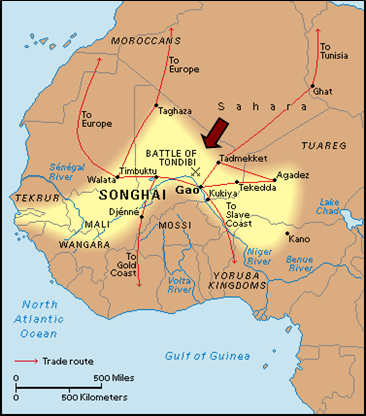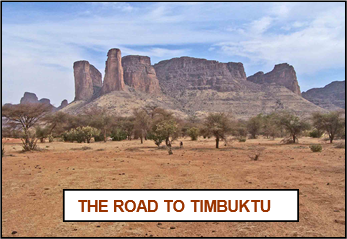


xxxxxAfter the coming to power of Sunni Ali in 1464, the Songhai Empire of West Africa began to grow again around the trading city of Timbuktu. As we have seen, by 1512 (H8) his successor Muhammed I had built an empire of great size. However, with the death of its leader Askia Dawud in 1582, a decline set in. The end came in 1591 when the Moroccans, equipped with firearms, swept down from the north, won a decisive victory at the Battle of Tondibi, and captured the important centres of Timbuktu and Gao.
THE END OF THE SONGHAI EMPIRE 1591 (L1)
Acknowledgements
Map (West Africa): licensed under Creative Commons – https://ridgeaphistory.wikispaces.com. Road to Timbuktu: date and photographer unknown.
 xxxxxIt was in the latter part of the fourteenth century that the Songhai Empire of West Africa -
xxxxxIt was in the latter part of the fourteenth century that the Songhai Empire of West Africa -
xxxxxDue in no small part to the sound administrative system established by Muhammed, the Songhai remained the dominant force in the area for some years after his death, but bitter disputes over the succession, and an increasing number of raids from neighbouring states seriously weakened the empire. The reign of Askia Dawud, an able leader, helped to restore peace and order for a time, but with his death in 1582 the end was in sight. The empire's most powerful neighbour, Morocco, began to step up its attacks, raiding the salt deposits of Taghaza, and threatening an all-
 xxxxxThis came in 1591 when, under their ambitious leader Issihak II, the Moroccans attacked in force. An army of some 4,000 men, equipped with firearms, managed to cross the Sahara. They advanced deep into Songhai territory and -
xxxxxThis came in 1591 when, under their ambitious leader Issihak II, the Moroccans attacked in force. An army of some 4,000 men, equipped with firearms, managed to cross the Sahara. They advanced deep into Songhai territory and -
Including:
The Battle
of Tondibi

L1-


